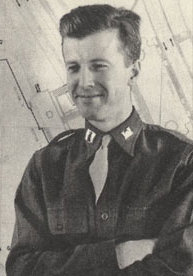Robert Furman facts for kids
Quick facts for kids
Robert Furman
|
|
|---|---|

Robert R. Furman
|
|
| Birth name | Robert Ralph Furman |
| Born | August 21, 1915 Trenton, New Jersey |
| Died | October 14, 2008 (aged 93) Adamstown, Maryland |
| Allegiance | |
| Service/ |
|
| Years of service | 1940–1946 |
| Rank | |
| Battles/wars | World War II: |
| Other work | Founder of Furman Builders Inc |
Robert Ralph Furman (born August 21, 1915 – died October 14, 2008) was a smart civil engineer. During World War II, he played a very important role. He was the chief of foreign intelligence for the Manhattan Project. This secret project worked on building the first atomic bombs.
Furman helped direct spy missions against Germany's own nuclear project. He also joined the Alsos Mission. This group worked to find and secure all the uranium in Europe. They wanted to keep it out of enemy hands. After the war, he helped gather German atomic scientists. This was to make sure they did not go to the Soviet Union.
He even personally took half of the special uranium-235 needed for the "Little Boy" atomic bomb. He transported it to the island of Tinian in the Pacific. Before the war, he also helped oversee the building of The Pentagon. After the war, he started his own construction company. It built many buildings, including the Potomac Mills shopping mall.
Contents
Early Life and Education
Robert Furman was born on August 21, 1915. His hometown was Trenton, New Jersey. He was one of five sons. His father worked at a bank. His mother was a riveter during World War II.
Furman went to Princeton University. He studied civil engineering and graduated in 1937. After college, he worked for a railroad company. He also worked for a construction company in New York.
Robert Furman's Role in World War II
In December 1940, Furman joined the United States Army Reserve. He was assigned to the Quartermaster Corps. This group handles supplies and construction for the army. He worked for Colonel Leslie R. Groves, Jr.. Furman helped supervise the daily building of The Pentagon.
When the Pentagon was finished in 1943, Colonel Groves got a new job. He was put in charge of the top-secret "Manhattan Project." Groves brought Furman with him to this new mission.
Spying on German Nuclear Plans
In August 1943, Furman took charge of an intelligence effort. This was because scientists working on the atomic bomb were worried. They thought Germany might be close to building its own nuclear weapon. As the director of intelligence, Furman's job was to find out how much progress Germany was making.
In December 1943, Groves sent Furman to Britain. They needed to set up an office there for the Manhattan Project. They also discussed how to work together on intelligence gathering.
Furman sent a spy named Moe Berg to Switzerland. Berg was supposed to meet Werner Heisenberg. Heisenberg was the head of Germany's nuclear project. After talking to Heisenberg, Berg realized Germany was far behind the Allies.
In June 1944, Furman traveled to Rome. He interviewed Italian scientists there. He wanted to learn more about Germany's project.
Finding and Securing Uranium
The Alsos Mission found documents in Belgium. These papers showed that Germany had received over 1,000 tons of uranium. But about 150 tons were still in Olen, Belgium. Groves sent Furman back to Europe. His orders were to secure this uranium.
The Alsos Mission found 68 tons of uranium in Olen. But 80 tons were missing. They had been sent to France in 1940. Groves had the Olen uranium shipped to England and then to the United States.
The missing uranium was tracked to Toulouse, France. An Alsos Mission team found 31 tons of uranium there. It was hidden in barrels. Furman supervised the loading of this uranium onto a ship. It was then sent to the United States.
Capturing German Scientists
In April 1945, Furman took part in "Operation Harborage." The Alsos Mission found a German experimental nuclear reactor in Haigerloch. They destroyed it and recovered uranium and heavy water.
On May 2, the Alsos Mission captured Heisenberg. Furman supervised his detention. He also oversaw the capture of nine other German scientists. They were taken to a country estate in England called Farm Hall. Their conversations were secretly listened to. This also kept them from going to the Soviet Union.
Delivering the Atomic Bomb Materials
In July 1945, Furman had a critical mission. He personally escorted half of the uranium-235 needed for the "Little Boy" atomic bomb. This bomb was later dropped on Hiroshima.
Furman traveled by car and then by air to California. He boarded the cruiser USS Indianapolis. The ship crossed the Pacific Ocean to Tinian island. They arrived on July 26. A few days after leaving Tinian, the Indianapolis was sunk by a Japanese submarine. More than 800 men were lost.
Later Life and Legacy
Furman left the army in 1946. He then started his own company, Furman Builders Inc. It was based in Rockville, Maryland. His company built many homes, schools, and commercial buildings. These included the Potomac Mills shopping mall. They also built the Metropolitan Baptist Church in Washington, D.C. His company even built the United States embassy in Nicaragua.
In 1952, he married Mary Eddy. They had two children, David and Serena. Mary Eddy also had two daughters from a previous marriage.
Furman usually kept quiet about his secret work during the war. He was president of his local Rotary Club. He also sang baritone in a barbershop quartet. He retired in 1993. Robert Furman passed away on October 14, 2008, at the age of 93.

